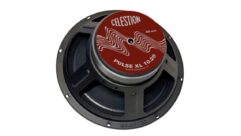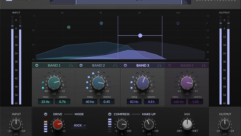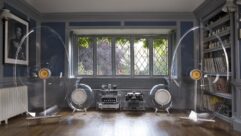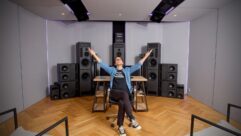
Bass Here, Not There
Sep 1, 2004 12:00 PM,
By Bruce Borgerson
Above top:
Twenty-driver forward steered array driver delay. Above bottom: JBL PD162-based
low-frequency array.
One of the few things taken for granted back in the good old days of sound reinforcement was that loudspeaker systems become essentially omnidirectional below about 250 Hz. Although directional control of the upper six octaves of the audio spectrum could be achieved using various horns and wave guides, the lowest three would radiate wherever they darn well pleased, which was pretty much everywhere.
The reason is simple: in these frequencies, the wavelengths involved are far longer than any reasonably sized loudspeaker system can contain. A 250 Hz wave is about 5 feet (1½ meters) long, and when you get down to 20 Hz, you have a full-cycle wave that is about 55 feet (17 meters) in length. Granted, you can exert effective control at only ¼ wavelength, but that still means fabricating a horn that is a minimum of 14 feet in diameter if you want to control sound at the lower limits of audibility.
BIG HORNS ABANDONED
Building horns of such gargantuan size is not particularly practical, though that doesn’t mean enterprising audio innovators didn’t give it a try. A decade before founding his current company, John Meyer constructed a quadraphonic system for a Bay Area nightclub using fiberglass conical horns more than eight feet in diameter. A few years later, in Pennsylvania, Community Sound founder Bruce Howze fashioned the first Leviathan bass horns for an early ’70s Elvis Presley tour. Although the original Leviathans found limited acceptance in concert touring (the truck pack was problematic), a weatherproofed Leviathan II version eventually found its way into several stadium installations.
If pressed on the subject, both of these audio pioneers would likely confess that their main concern was efficient coupling for greater power and not achieving significant directional control. But the importance of efficiency has diminished over the years as more robust drivers and lightweight, high-watt amplifiers now provide ample bass output using compact, folded horn designs and direct radiators. Consequently, though huge horns could provide a measure of directionality, most have vanished from the audio marketplace.

NEXO CD12
HIGHER-TECH SOLUTIONS
If sound waves can’t be directed using a solid, physical wave guide, then your only alternative is using other sound waves as the controlling mechanism. The basic concept is quite simple: reinforce the waves in the direction you want them to go and cancel them in the direction you don’t want them to go. It’s a concept elegantly simple in principle yet difficult to accomplish in any practical loudspeaker system. Little was done to create working products until increasing demand intersected with new technology during the past decade.
The driving force behind these recent developments has been the increasing level of bass demanded out front by audiences and mixing engineers. When more bass goes out the front, that means that more bass goes out the back, over the top, and around the sides. In concert applications, that often translates into boomy, mushy bass in larger venues and a stage and backstage area awash with unwanted low-frequency sound.
A similar problem has emerged in outdoor applications, when bass escapes from the venue and vibrates into adjoining residential neighborhoods. Even though the performance may comply with sound level ordinances according to weighted curves, irate neighbors nevertheless complain about relentless “boom and thump.” Low-frequency control is needed to contain the offending waves within the immediate vicinity of the venue.

Community Leviathan, circa 1970s
These vexing problems developed at a rapid pace through the late 1980s and into the 1990s. Fortunately, so did the technology needed to solve them. Today more than a dozen solutions are available from at least six manufacturers. This article will first examine systems based on the familiar cardioid effect and then consider forward-steered products as well as other custom-engineered approaches.
CARDIOID: ONE-BOX SOLUTIONS
In 1998 Meyer Sound introduced its first dedicated directional bass product, the PSW-6. The company followed with two directional bass cabinets for its line array series in 2001, the M3D and M3D-Sub. All three are self-powered and therefore offer a one-box solution: an audio signal goes in, and directional bass comes out.
Interestingly, though exhaustive computer modeling was employed in the design of these products, the internal processing circuits for the systems are realized in the analog domain. The cardioid effect is achieved through integration of rear-firing transducers, internal cabinet acoustics, and sophisticated phase manipulation circuits.

M3D-Sub polar data
The PSW-6 is a trapezoidal system that is designed for horizontal arraying. It contains two forward-aimed 18-inch transducers and four 15-inch transducers, one pair firing forward and a second pair facing the rear. Frequency range is 30 Hz to 125 Hz, with a minimum rear attenuation of 15 dB (20 dB typical), according to the company.
The M3D-Sub is similar in many respects to the PSW-6, but the rectangular box cabinet contains only four transducers: two front 18-inch and two rear 15-inch. The M3D is actually a full-range unit but is included here because directional response extends to 35 Hz. The M3D comprises four 15-inch cone drivers, two facing each direction, along with the high-frequency compression drivers and associated wave guides.
CARDIOID: THREE-BOX APPROACHES
Both NEXO and Adamson Systems Engineering have introduced cardioid subwoofers that use external signal processing and amplification. Compared with the one-box systems, this multibox approach allows for some tweaking of coverage patterns by employing different variations in the digital signal-processing (DSP) algorithms. Certainly this can prove advantageous if done properly by skilled personnel, though the downside is that inadvertent or unauthorized alterations (for example, to amplifier gain settings) can detract from the desired directional effects.
NEXO offers two subwoofer cabinets that, when used in conjunction with presets in the company’s NX242 DSP unit, can be used to create directional response patterns. Two discrete DSP outputs are required to achieve the effect, with each output connected to separate amplifier channels for the forward- and rear-firing loudspeaker inside each cabinet.

Meyer Sound M3D-Sub
NEXO’s CD12 subwoofer, designed to work primarily with the company’s compact GEO S line array systems, incorporates a pair of 12-inch cone transducers. The two transducers are wired in opposite polarity, with a frequency-dependent delay applied to the front woofer. The units may be ground stacked or flown behind NEXO’s full-range line array components. Peak sound-pressure level (SPL) is given as 131 to 134 dB within the frequency range of 39 to 250 Hz (-6 dB points). The CD12 exhibits a response pattern of 120 degrees horizontal and vertical, with rear attenuation of 15 to 20 dB.
NEXO also offers the CD18 subwoofer, designed for higher-power applications. Each CD18 contains two 18-inch transducers and, according to published specifications, is capable of 143 dB SPL peak output in a frequency range (-6 dB) of 29 to 180 Hz. Alteration of the DSP settings accommodates variation between cardioid and supercardioid patterns on the CD12 or CD18, which allows narrowing of the front pattern at the expense of a larger rear lobe. Maximum off-axis with the supercardioid pattern is about 20 dB at the deepest null point, but overall front-to-back ratio remains typically 12 to 15 dB.
ADAMSON’S CONVERTIBLE
When configured for directional effect, Adamson’s new SpekTrix Sub functions in much the same way as the NEXO subwoofers. The Adamson unit contains dual 18-inch drivers facing opposite directions in a tuned sound chamber. The connectors and rigging are designed in such a way as to allow cabinets to be flown or stacked facing backward, in alternating front- and rear-facing pairs, thus allowing the cardioid effect to be implemented by using the proper preset algorithms in Adamson’s DX6000 processor.

EAW MQTD812 subwoofer
This convertible cardioid solution allows flexibility in tailoring bass coverage and intensity depending on applications, according to Adamson. For example, the cardioid effect may be desired for classical or light pop music with a free-air flown array, but a conventional pattern may be preferred for reggae or dance music when the array can benefit from rear wall loading. Frequency range is given as 40 to 170 Hz (-3 dB).
LOOKING FORWARD
The next two product groups, from Bose and JBL respectively, employ variations on forward-steering or beam-steering technologies. Instead of using rear-facing drivers to create cancellation effects, these systems use spaced driver arrays and carefully timed signal delays to steer bass energy in defined directions.
The straightforward Bose solution takes an appropriate existing product and provides means to quickly assemble directional arrays. To achieve desired spacing between transducers, Bose provides brackets for attachment to the ends of the company’s relatively compact modular subwoofers. Variations in low-frequency coverage patterns are accommodated simply by changing the number and orientation of modules in the array and by using a different set of appropriate delays in the associated DSP controller. For example, the MB4 subwoofers can be configured as a 4-unit Endfire array with most bass energy directed forward in both horizontal and vertical axes or as a two-unit Broadside array with omnidirectional horizontal coverage but with 10 to 15 dB suppression on the vertical axis. Effective frequency range for both is from 80 to 200 Hz. Peak acoustic output for the Endfire is given as 122 dB SPL, and the Broadside is said to produce 116 dB SPL. Presets in the Bose Panaray controller are designed for optimum results with each array configuration.
JBL has incorporated this same underlying concept, though on a much larger scale, into a series of modular subwoofers designed for use with the company’s new Precision Directivity (PD) series of loudspeaker systems. JBL offers three modular systems to accommodate different requirements. The PD 162 (six 12-inch drivers) is designed to steer bass in the 125 to 300 Hz range, and the PD125/135 use 15-inch drivers for the 40 Hz to 250 Hz range. For deep bass, the PD128 offers a pair of 18-inch drivers in each enclosure.

Top: MB4 4x Endfire horizontal and vertical octave-band polar data. Bottom: Bose Panaray MB4 4x Endfire bass array.
The steerable arrays are configured using multiple modules and applying the proper delays and frequency shading algorithms using an associated DSP unit. For example, in the PD162 arrays, the steering is accomplished by progressively delaying each pair of transducers to a reference plane that is perpendicular to the direction of steering. The drivers are mounted in a novel motor out arrangement to keep the array as narrow as possible and to accommodate motor cooling. Arrays of the PD125 and PD128 modules work in a similar fashion, though the cabinet and mounting schemes are different in order to optimize system efficiency and provide greater spacing of elements as required by the longer wavelengths.
Although the modules are offered as standard products, the arrays are normally custom configured in consultation with JBL. Performance will vary with different array configurations, but JBL cites a large covered stadium using six arrays of 12 each PD125 array elements as an example. For the stated bandwidth (50 Hz to 250 Hz), JBL states a rear rejection of 9 to 15 dB, vertical beam width of 90 degrees, and long-term SPL 108 dB at a distance of 120 feet.
TUNED DIPOLAR AND TRIPOLAR ARRAYS
EAW created its Tuned Dipolar Array technology to achieve significant amounts (10 to 12 dB) of vertical attenuation in the problematic midbass regions. Designed for use with companion mid-high cabinets in horizontal arrays, these cabinets use frequency shading algorithms in associated DSP units to control separate amplifier signals to the paired drivers in each unit. When arrayed overhead, the directional effect limits the amount of midbass bleed down onto the stage area. According to EAW, it is most useful in wider venues where horizontal arrays address audiences spread out in a fan-shaped auditorium.
EAW lists three current products incorporating the directional technology. The MQTD412 employs two vented 12-inch woofers and two sealed 8-inch woofers in a trapezoidal enclosure for effective response from 160 Hz to 500 Hz. The MQTD812 uses four of each transducer to cover the same range but with higher output. The MQTD415 incorporates two vented 15-inch woofers and two sealed 12-inch drivers to cover the range of 110 Hz to 300 Hz.
Renkus-Heinz has applied the same principles to its semicustom, preconfigured tripolar array systems. The company’s in-house design group configures the full-range arrays according to customer requests, and when desired the arrays can include directional low-frequency components by using specified products in conjunction with dedicated DSP. For example, the TRAP-SVBK bass cabinet has two 15-inch drivers mounted in separate tuned and vented chambers, allowing them to operate together as a conventional subwoofer or independently as part of tripolar array with wide bandwidth directional control.
CUSTOM SOLUTIONS AVAILABLE
Implementing the technology is largely a matter of driver spacing, relative driver orientation, and manipulation of the inputs to the various drivers using some kind of signal processing. Thus, solutions can be created using custom cabinets or even off-the-shelf cabinets in custom configured arrays. At least one manufacturer contacted has a directional bass product nearing completion but requested that it not be included. Quite likely, others will follow. As audiences demand more bass, more venues will seek effective solutions for steering “big bottom” where it is wanted — and away from where it isn’t.
Bruce Borgersonis principal of Wavelength Communications, a consulting firm in Ashland, Oregon.
Web Exclusive
TAKE CONTROL
Go to www.svconline.com for an online exclusive on how to configure your existing omnidirectional subwoofer system to gain directional control.
For More Information
Adamson Pro Audio
www.adamsonproaudio.com
Bose
www.bose.com
Community Professional Loudspeakers
www.loudspeakers.net
EAW
www.eaw.com
JBL Professional
www.jblpro.com
Meyer Sound
www.meyersound.com
NEXO
www.nexo.fr
Renkus-Heinz
www.renkus-heinz.com










